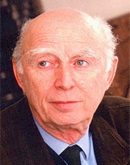

Bruno Morassutti
Biography
Bruno Morassutti was an Italian modernist architect. After studying at a classical lyceum (1937-40) in Padua, he enrolled at IUAV in Venice, where he studied architecture under Prof. Giuseppe Samonà, Egle Renata Trincanato, and Carlo Scarpa. He received his diploma in 1946, when fewer than ten students graduated. Among his classmates were Marcello D’Olivo, Edoardo Gellner, Gianni Avon, and Angelo Masieri. He then worked for two years in his brother Giovanni's studio and in 1949 traveled to the USA, where he spent time at F.L. Wright’s studios in Taliesin, Wisconsin, and later at Taliesin West in Arizona. Before returning to Italy, he traveled across America to visit the works of L.M.v.d.Rohe, R.Neutra, and F.L. Wright. He gathered extensive photographic documentation, which he used in his teaching and at conferences. He also published his findings from Taliesin on the pages of the magazine Domus, featuring two Wright projects.
Among his first realized works was a holiday home for his family in Jesolo (1954). He briefly collaborated with Carlo Scarpa on the Romanelli villa in Udine (1954-56). He then moved to Milan, where he worked with architect Angelo Mangiarotti and engineer Aldo Favini, whom he invited to tackle the most complex projects focusing mainly on structural experimentation and innovative industrialization of buildings using prefabricated construction modules and components.
In the early 1960s, he ended his partnership with Mangiarotti and in 1969 established the studio Morassutti & Associati Architetti (with Maria Gabriella Benevento, Giovanna Gussoni, Mario Memoli, and Aldo Favini). This period marks a number of prefabricated residential projects. In the last two decades, Morassutti's interest turned primarily to themes of religious architecture and public space.
Bruno Morassutti was an Italian modernist architect. After studying at a classical lyceum (1937-40) in Padua, he enrolled at IUAV in Venice, where he studied architecture under Prof. Giuseppe Samonà, Egle Renata Trincanato, and Carlo Scarpa. He received his diploma in 1946, when fewer than ten students graduated. Among his classmates were Marcello D’Olivo, Edoardo Gellner, Gianni Avon, and Angelo Masieri. He then worked for two years in his brother Giovanni's studio and in 1949 traveled to the USA, where he spent time at F.L. Wright’s studios in Taliesin, Wisconsin, and later at Taliesin West in Arizona. Before returning to Italy, he traveled across America to visit the works of L.M.v.d.Rohe, R.Neutra, and F.L. Wright. He gathered extensive photographic documentation, which he used in his teaching and at conferences. He also published his findings from Taliesin on the pages of the magazine Domus, featuring two Wright projects.
Among his first realized works was a holiday home for his family in Jesolo (1954). He briefly collaborated with Carlo Scarpa on the Romanelli villa in Udine (1954-56). He then moved to Milan, where he worked with architect Angelo Mangiarotti and engineer Aldo Favini, whom he invited to tackle the most complex projects focusing mainly on structural experimentation and innovative industrialization of buildings using prefabricated construction modules and components.
In the early 1960s, he ended his partnership with Mangiarotti and in 1969 established the studio Morassutti & Associati Architetti (with Maria Gabriella Benevento, Giovanna Gussoni, Mario Memoli, and Aldo Favini). This period marks a number of prefabricated residential projects. In the last two decades, Morassutti's interest turned primarily to themes of religious architecture and public space.
The English translation is powered by AI tool. Switch to Czech to view the original text source.











